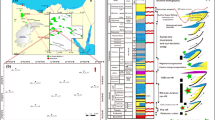Abstract
Based on the observation, study and analysis of core data, thin section, well logging and drilling data, the sedimentary facies, diagenetic facies and fracture facies of the carbonate reservoirs were carried out in Carboniferous Formation KC, KX oilfield, Caspian Basin. In this paper, the petrophysical facies of oil intervals in KC formation were examined to evaluate the pore and fracture structure and to predict zones with high porosity and permeability by classification. The petrophysical facies were divided by the superposition and combination of sedimentary facies, diagenetic facies and fracture facies. And a series of petrophysical facies of KC formation such as the pore-dissolved vuggy, the fracture-pore type, the high-angle connected fracture, were identified in this way. There are four main categories of petrophysical facies (PF-I, PF-II, PF-III and PF-IV), which are characterized based on the constructive and destructive effect of sedimentary facies, diagenetic facies and fracture facies on the reservoir property and pore structure in KC formation. Since the reservoir quality index (RQI) and the limestone structure parameter (LSP) are the important factors for describing the reservoir micro-pore and fracture structure quantitatively, both RQI and LSP values were calculated respectively in the different petrophysical facies. Therefore, the classification and evaluation of KC formation reservoir pore structure in a single well were realized by the classification of petrophysical facies combined with well logging and core data. Finally, the vertical and horizontal distribution of sedimentary micro-facies and diagenetic facies of each single layer of KC formation were plotted, the distribution of favorable petrophysical facies can be used to predict the zones with high porosity and permeability.
Access this chapter
Tax calculation will be finalised at checkout
Purchases are for personal use only
Similar content being viewed by others
References
Sun, S.Q., Esteban, M.: Paleoclimatic controls on sedimentation, diagenesis, and reservoir quality: Lessons from M iocene carbonates. AAPG Bull. 78, 519–543 (1994)
Caineng, Z., et al.: The formation conditions and distribution characteristics of continuous petroleum accumulations. Acta Petrol. Sinica 30(3), 324–331 (2009)
Caineng, Z., et al.: Genesis, classification and evaluation method of diagenetic faties. Petrol. Explor. Dev. 35(5), 526–540 (2008)
Shenghe, W.: Reservoir Characterization and Modeling, pp. 217–221. Petroleum Industry Press, Bei**g (2010)
Francesconi, A., Bigoni, F., Balossino, P., Bona, N., Marchini, F., Cozzi, M.: Reservoir Rock Types Application-Kashagan. Society of Petroleum Engineers, SPE-125342-MS
Lin, Y., et al.: A Well Log Identification Method of Complex Carbonate Reservoir Lithotypes and Lithofacies: A Case Study on Formation Unit B in K Oil Field, Caspian Basin, Kazakhstan. Society of Petroleum Engineers, SPE-182095-MS
Skalinski, M., Gottlib-Zeh, S., Moss, B.: Defining and Predicting Rock Types in Carbonates - Preliminary Results from an Integrated Approach using Core and Log Data from the Tengiz Field. Society of Petrophysicists and Well-Log Analysts, SPWLA-2006-v47n1a3
Amaefule, J.O.: Enhanced reservoir description: using core and log data to identify hydraulic flow unit and predict permeability in uncored intervals/wel1. SPE26436. In: 68th Annual SPE Conference and Exhibition, Houston, Texas (1993)
Al-Dabbas, M., Al-Jassim, J., Al-Jumaily, S.: Depositional environments and porosity distribution in regressive limestone reservoirs of the Mishrif formation, Southern Iraq. Arab. J. Geosci. 3(1), 67–78 (2010)
Tanguay, L.H., Friedman, G.M.: Petrophysieal facies of the Ordovician Red River formation. Williston Basin. Carbon. Evap. 16(1), 71–92 (2001)
Ning, Y., et al.: Researches of the control factors and the quantitatively characterization method of reservoir petrophysical facies. Geolog. Rev. 59(3), 563–574 (2013)
Ning, L., Bo, W., Yanjuan, X., Jianmin, Z., Baozhi, P.: Auto-classification and evaluation of reservoirs with logs based on capillary pressure curves. Well Logging Technol. 37(6), 653–657 (2013)
Acknowledgments
The project is supported by the Special and Significant Project of National Science and Technology “Global oil and gas resources assessment and constituencies with research” (Number: 2016ZX05029, 2019D-4307).
Author information
Authors and Affiliations
Corresponding author
Editor information
Editors and Affiliations
Copyright information
© 2022 The Author(s), under exclusive license to Springer Nature Singapore Pte Ltd.
About this paper
Cite this paper
Lin, Yp., Wang, Z., Zheng, Jz., Luo, M., Hou, J. (2022). Classification and Evaluation of Reservoir Pore Structures Based on Petrophysical Facies: A Case Study on Formation KC in KX Field, Caspian Basin. In: Lin, J. (eds) Proceedings of the International Field Exploration and Development Conference 2021. IFEDC 2021. Springer Series in Geomechanics and Geoengineering. Springer, Singapore. https://doi.org/10.1007/978-981-19-2149-0_70
Download citation
DOI: https://doi.org/10.1007/978-981-19-2149-0_70
Published:
Publisher Name: Springer, Singapore
Print ISBN: 978-981-19-2148-3
Online ISBN: 978-981-19-2149-0
eBook Packages: Earth and Environmental ScienceEarth and Environmental Science (R0)




